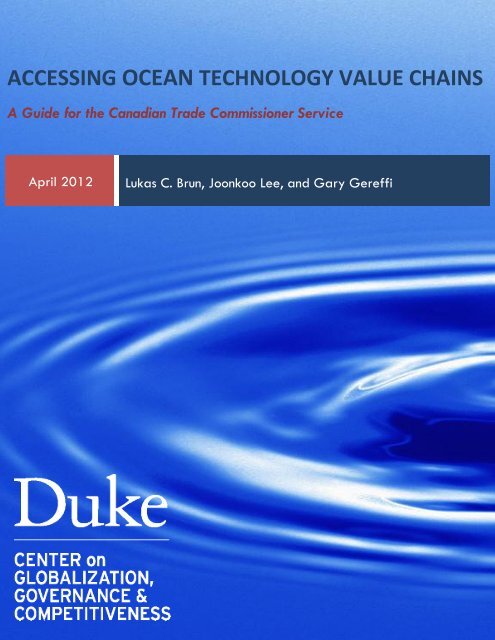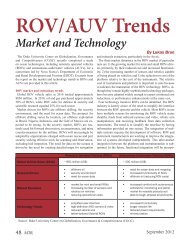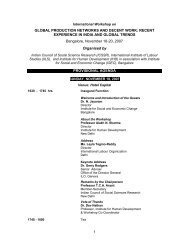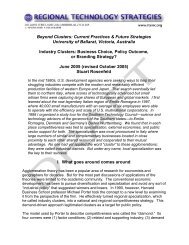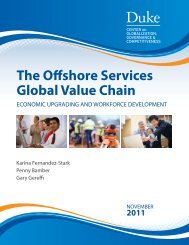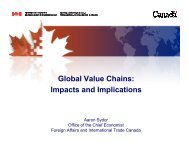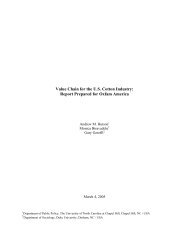Accessing Ocean Technology Value Chains - Center on ...
Accessing Ocean Technology Value Chains - Center on ...
Accessing Ocean Technology Value Chains - Center on ...
You also want an ePaper? Increase the reach of your titles
YUMPU automatically turns print PDFs into web optimized ePapers that Google loves.
ACCESSING OCEAN TECHNOLOGY VALUE CHAINS<br />
A Guide for the Canadian Trade Commissi<strong>on</strong>er Service<br />
April 2012 Lukas C. Brun, Jo<strong>on</strong>koo Lee, and Gary Gereffi
<str<strong>on</strong>g>Accessing</str<strong>on</strong>g> <str<strong>on</strong>g>Ocean</str<strong>on</strong>g> <str<strong>on</strong>g>Technology</str<strong>on</strong>g> <str<strong>on</strong>g>Value</str<strong>on</strong>g> <str<strong>on</strong>g>Chains</str<strong>on</strong>g><br />
This report was sp<strong>on</strong>sored by the Canada Department of Foreign Affairs and Internati<strong>on</strong>al Trade (DFAIT) for the<br />
Trade Commissi<strong>on</strong>er Service. We gratefully acknowledge Jane Rutherford for sp<strong>on</strong>soring the project.<br />
Errors of fact or interpretati<strong>on</strong> remain the exclusive resp<strong>on</strong>sibility of the authors. The opini<strong>on</strong>s or comments<br />
expressed in this study are not endorsed by DFAIT or the Trade Commissi<strong>on</strong>er Service. We welcome comments<br />
and suggesti<strong>on</strong>s. The corresp<strong>on</strong>ding author can be c<strong>on</strong>tacted at lukas.brun@duke.edu.<br />
© April 2012 <str<strong>on</strong>g>Center</str<strong>on</strong>g> <strong>on</strong> Globalizati<strong>on</strong>, Governance & Competitiveness, Duke University<br />
Page 1
SUMMARY<br />
<str<strong>on</strong>g>Accessing</str<strong>on</strong>g> <str<strong>on</strong>g>Ocean</str<strong>on</strong>g> <str<strong>on</strong>g>Technology</str<strong>on</strong>g> <str<strong>on</strong>g>Value</str<strong>on</strong>g> <str<strong>on</strong>g>Chains</str<strong>on</strong>g><br />
This guide is for trade commissi<strong>on</strong>ers working with Canadian small and medium-sized enterprises (SMEs) to<br />
access and upgrade capabilities in ocean technology global value chains. The guide provides a list of<br />
informati<strong>on</strong> to collect <strong>on</strong> ocean technology companies in Canada and abroad to increase the participati<strong>on</strong><br />
of Canada’s SMEs in ocean technology global value chains.<br />
TABLE 1: Overview of recommended activities<br />
Activity What Why How Who<br />
Identify<br />
capabilities<br />
of domestic<br />
firms<br />
Collect<br />
informati<strong>on</strong><br />
<strong>on</strong> foreign<br />
markets<br />
C<strong>on</strong>nect<br />
with<br />
business<br />
networks<br />
Identify the firm’s:<br />
entry point in the global<br />
value chain<br />
level of capability<br />
upgrading trajectory<br />
In area of geographic<br />
resp<strong>on</strong>sibility, identify:<br />
leading producers and buyers<br />
the demand and use of ocean<br />
technology<br />
market and technology<br />
trends<br />
Informati<strong>on</strong> <strong>on</strong> standards and<br />
certificati<strong>on</strong><br />
Lead firms’ supply chain<br />
management strategies<br />
Create value chain maps<br />
illustrating key actors at the<br />
geographic, company, and<br />
product level.<br />
C<strong>on</strong>nect with research, business,<br />
and financial networks in area of<br />
geographic resp<strong>on</strong>sibility<br />
Collecting this informati<strong>on</strong>:<br />
identifies the firm’s product<br />
or service category<br />
assesses the firm’s<br />
sophisticati<strong>on</strong> in its product<br />
or service offering<br />
identifies the firm’s path for<br />
capturing a greater share of<br />
the value in the product or<br />
service market<br />
Collecting this informati<strong>on</strong><br />
identifies:<br />
who to target<br />
what products are most<br />
relevant in the market<br />
level of technology<br />
development<br />
how access to the ocean<br />
technology value chain is<br />
c<strong>on</strong>trolled in the geographic<br />
area<br />
Networks provide informati<strong>on</strong><br />
about<br />
emerging market and<br />
technology trends<br />
commercializati<strong>on</strong><br />
opportunities<br />
financial resources<br />
skilled labor<br />
C<strong>on</strong>duct company research using:<br />
electr<strong>on</strong>ic resources and<br />
databases<br />
industry trade journals<br />
interviews with companies<br />
C<strong>on</strong>duct interviews with:<br />
leading firms<br />
ec<strong>on</strong>omic development<br />
authorities<br />
industry cluster organizati<strong>on</strong>s<br />
universities and research<br />
institutes<br />
professi<strong>on</strong>al societies<br />
A list of sample questi<strong>on</strong>s to ask<br />
during interviews is provided in<br />
Attachment A.<br />
A primer for value chain analysis is<br />
available here<br />
C<strong>on</strong>duct interviews with:<br />
leading firms<br />
ec<strong>on</strong>omic development<br />
authorities<br />
industry cluster organizati<strong>on</strong>s<br />
universities and research<br />
institutes<br />
professi<strong>on</strong>al societies<br />
Trade<br />
commissi<strong>on</strong>ers<br />
stati<strong>on</strong>ed<br />
in Canada<br />
Trade<br />
commissi<strong>on</strong>ers<br />
stati<strong>on</strong>ed<br />
abroad<br />
Trade<br />
commissi<strong>on</strong>ers<br />
stati<strong>on</strong>ed<br />
in Canada<br />
and abroad<br />
Page 2
<str<strong>on</strong>g>Accessing</str<strong>on</strong>g> <str<strong>on</strong>g>Ocean</str<strong>on</strong>g> <str<strong>on</strong>g>Technology</str<strong>on</strong>g> <str<strong>on</strong>g>Value</str<strong>on</strong>g> <str<strong>on</strong>g>Chains</str<strong>on</strong>g><br />
Activity What Why How Who<br />
Match<br />
foreign<br />
market<br />
needs with<br />
domestic<br />
capability<br />
Transmit<br />
market and<br />
competitiveness<br />
informati<strong>on</strong><br />
Source: Duke CGGC<br />
Close identified market gaps in<br />
foreign market with capable<br />
domestic firms.<br />
Act as a c<strong>on</strong>duit of informati<strong>on</strong> for<br />
government actors in Canada<br />
about technology trends,<br />
commercializati<strong>on</strong> opportunities,<br />
and public policies affecting the<br />
competitiveness of the ocean<br />
technology sector abroad.<br />
RECOMMENDED ACTIVITIES<br />
Provides market opportunities for<br />
Canadian firms.<br />
Identifies innovative policies,<br />
emerging technology and market<br />
trends, which can be used to<br />
increase the competitiveness of<br />
the Canadian ocean technology<br />
sector.<br />
Provide informati<strong>on</strong> to Canadian<br />
firms about the demand for<br />
products and services in the<br />
foreign market, including key<br />
c<strong>on</strong>tacts.<br />
Provide to foreign firms<br />
informati<strong>on</strong> about Canadian SME<br />
products, services and capabilities<br />
across the value chain.<br />
Provide informati<strong>on</strong> to Canadian<br />
nati<strong>on</strong>al, provincial, and local<br />
governments about innovative<br />
policies supporting the ocean<br />
technology sector abroad. These<br />
include commercializati<strong>on</strong><br />
assistance, eminent scholars<br />
programs, and tax and subsidy<br />
policies targeted <strong>on</strong> the ocean<br />
technology sector, or high<br />
technology sectors generally.<br />
Provide informati<strong>on</strong> to<br />
universities, oceanographic<br />
instituti<strong>on</strong>s, and public-private<br />
partnerships (<str<strong>on</strong>g>Center</str<strong>on</strong>g>s of<br />
Excellence) about emerging<br />
technology trends and<br />
commercializati<strong>on</strong> opportunities<br />
in foreign markets.<br />
1. Identify capabilities of domestic firms<br />
Key questi<strong>on</strong>: What is the firm’s entry point, level of capability, and upgrading trajectory in the global value<br />
chain?<br />
The entry point of a firm in the global value chain identifies the firm’s product or service category.<br />
The level of capability assesses the firm’s sophisticati<strong>on</strong> in its product or service offering.<br />
The upgrading trajectory identifies the firm’s path for capturing a greater share of the value of a<br />
product or service.<br />
Entry point: Knowing the company’s products, services, and end-markets identifies the SME’s market niche.<br />
Understanding the company’s line of business is a necessary first step for all other activities recommended<br />
by this guide. Industry classificati<strong>on</strong> systems (NAICS, SIC, DUNS) are useful for identifying in what industry<br />
the firm is located. SMEs in ocean technology value chains tend to fall into two major categories: product<br />
Trade<br />
commissi<strong>on</strong>ers<br />
stati<strong>on</strong>ed<br />
in Canada<br />
Trade<br />
commissi<strong>on</strong>ers<br />
stati<strong>on</strong>ed<br />
abroad<br />
Page 3
Pre-producti<strong>on</strong><br />
Producti<strong>on</strong><br />
Post-producti<strong>on</strong><br />
<str<strong>on</strong>g>Accessing</str<strong>on</strong>g> <str<strong>on</strong>g>Ocean</str<strong>on</strong>g> <str<strong>on</strong>g>Technology</str<strong>on</strong>g> <str<strong>on</strong>g>Value</str<strong>on</strong>g> <str<strong>on</strong>g>Chains</str<strong>on</strong>g><br />
comp<strong>on</strong>ent manufacturers, and service providers to lead firms. Product comp<strong>on</strong>ent manufacturers develop<br />
software or hardware products for use in larger systems. Service providers in the ocean technology sector<br />
can range from support services for product manufacturers to c<strong>on</strong>sulting services for end-users.<br />
Level of capability: A firm’s capability in pre-producti<strong>on</strong>, producti<strong>on</strong>, and post-producti<strong>on</strong> activities can<br />
range from low to high. Identifying the level of sophisticati<strong>on</strong> in each of these activities assists in identifying<br />
potential trade partners abroad and upgrading trajectories for the firm. A table useful for assessing the<br />
capability of firms is provided below.<br />
TABLE 2: Firm capability, by value chain stage and segment<br />
Stage<br />
<str<strong>on</strong>g>Value</str<strong>on</strong>g><br />
Chain<br />
Segment<br />
Research &<br />
Design<br />
Purchasing<br />
Producti<strong>on</strong><br />
Marketing,<br />
distributi<strong>on</strong><br />
and postproducti<strong>on</strong><br />
services<br />
Source: Duke CGGC<br />
Capability<br />
Level Activity Example<br />
Low<br />
Medium<br />
Product design modificati<strong>on</strong> and<br />
customizati<strong>on</strong><br />
Applied research and new product<br />
design<br />
High Basic ocean technology research<br />
Low<br />
Medium<br />
High<br />
Local search for supply chain<br />
partners<br />
Local and regi<strong>on</strong>al search for supply<br />
chain partners + practice of simple<br />
supply chain management practices<br />
Regi<strong>on</strong>al and/or global search for<br />
supply chain partners +<br />
sophisticated supply chain<br />
management practices<br />
Low Simple comp<strong>on</strong>ent manufacture<br />
Medium<br />
High<br />
Simple comp<strong>on</strong>ent manufacture +<br />
assembly<br />
Fully integrated manufacture +<br />
assembly; high-tech comp<strong>on</strong>ent<br />
producti<strong>on</strong><br />
Low Domestic distributi<strong>on</strong><br />
Medium<br />
High<br />
Domestic + internati<strong>on</strong>al distributi<strong>on</strong><br />
and marketing activities<br />
Domestic + internati<strong>on</strong>al distributi<strong>on</strong><br />
and marketing activities + advanced<br />
post-producti<strong>on</strong> services, such as<br />
c<strong>on</strong>sulting & training<br />
Re-designing ships for c<strong>on</strong>versi<strong>on</strong> and refitting<br />
Developing a new hull design for icebreakers with<br />
advanced icebreaking capability; developing paint to<br />
minimize hull fricti<strong>on</strong><br />
C<strong>on</strong>ducting scientific research to reduce hull fricti<strong>on</strong><br />
caused by the ice<br />
OT platform manufacturer identifies metal finishing<br />
c<strong>on</strong>tractors within 20 km of plant<br />
OT platform manufacturer scans for regi<strong>on</strong>al metal<br />
finishing service providers and maintains informal<br />
quality assessments of suppliers<br />
OT platform manufacturer seeks “best in class”<br />
comp<strong>on</strong>ent producers and evaluates suppliers with<br />
balanced scorecards<br />
Producing comp<strong>on</strong>ents for mature ocean sensors, such<br />
as pH sensors.<br />
Assembly of commercial off-the-shelf technology into<br />
a new product, or producti<strong>on</strong> of moderately<br />
sophisticated comp<strong>on</strong>ents, such as remotely-operated<br />
vehicle (ROV) winches.<br />
Producing sophisticated navigati<strong>on</strong> systems for ROVs,<br />
such as dynamic positi<strong>on</strong>ing systems.<br />
Domestic distributi<strong>on</strong> and repair network for handheld<br />
s<strong>on</strong>ars.<br />
Operating internati<strong>on</strong>al distributi<strong>on</strong> networks of a<br />
wide-range of ocean technology products, from<br />
marine sensors to ROVs.<br />
Providing post-producti<strong>on</strong> services for ROV/AUV, such<br />
as leasing and operating, c<strong>on</strong>sulting and training, in<br />
additi<strong>on</strong> to the distributi<strong>on</strong> and sales of ROV/AUV<br />
Page 4
<str<strong>on</strong>g>Accessing</str<strong>on</strong>g> <str<strong>on</strong>g>Ocean</str<strong>on</strong>g> <str<strong>on</strong>g>Technology</str<strong>on</strong>g> <str<strong>on</strong>g>Value</str<strong>on</strong>g> <str<strong>on</strong>g>Chains</str<strong>on</strong>g><br />
Upgrading trajectory: Upgrading refers to the movement of a company’s activities to capture a greater<br />
share of the value in a product or service. In most sectors, the value-added at each segment of the value<br />
chain varies. In high technology sectors, product manufacturing c<strong>on</strong>tributes a lower percentage to the<br />
product’s final value than pre-producti<strong>on</strong> activities, such as R&D and design, or post-producti<strong>on</strong> activities,<br />
such as marketing and services. i This “smile curve” is found in many other high technology sectors,<br />
including ocean technology.<br />
FIGURE 1: <str<strong>on</strong>g>Value</str<strong>on</strong>g> added in the ocean technology value chain<br />
Source: adapted from Dedrick, Kraemer & Tsai, 1999<br />
Upgrading expands the activity of the firm to porti<strong>on</strong>s of the value chain that capture a greater share of the<br />
total value of a product or service, thus increasing the competitiveness of the firm.<br />
TABLE 3: Upgrading in the ocean technology sector<br />
Entry into the<br />
value chain<br />
<str<strong>on</strong>g>Value</str<strong>on</strong>g> Chain Segments Descripti<strong>on</strong> Example<br />
Firm offers ocean technology products or<br />
services.<br />
Focus of the company may be relatively<br />
narrow to focus <strong>on</strong> a specific customer,<br />
product, service or end-market.<br />
Company produces tethers for<br />
ROVs.<br />
Company provides mapping<br />
services for an oil and gas<br />
company.<br />
Page 5
Developing better<br />
products or services<br />
(Product Upgrading)<br />
Expansi<strong>on</strong> across<br />
value chain segments<br />
(Functi<strong>on</strong>al Upgrading)<br />
Increasing productivity<br />
(Process Upgrading)<br />
Selling across end-markets<br />
(Inter-sectoral Upgrading)<br />
Source: Duke CGGC<br />
<str<strong>on</strong>g>Value</str<strong>on</strong>g> Chain Segments Descripti<strong>on</strong> Example<br />
Company offers better, higher quality<br />
products and/or services.<br />
Focus of the company is to increase unit<br />
value of products or services offered.<br />
Firm adds services to existing product<br />
manufacturing or adds product<br />
manufacturing to services.<br />
Focus of the company expands to an<br />
increasing number of value chain segments,<br />
products, or services.<br />
Company may carry out pre-producti<strong>on</strong><br />
processes, such as design or product<br />
development with a major customer or<br />
research partner.<br />
Company focuses <strong>on</strong> increasing the<br />
productivity of value chain segments.<br />
Rec<strong>on</strong>figures producti<strong>on</strong> processes, pre-<br />
and post-producti<strong>on</strong> activities to become<br />
more efficient.<br />
Out-sourcing and in-sourcing are<br />
c<strong>on</strong>sidered as opti<strong>on</strong>s for increasing<br />
productivity.<br />
Company finds new product markets for<br />
existing products, or modifies existing<br />
products for customers in new endmarkets.<br />
<str<strong>on</strong>g>Accessing</str<strong>on</strong>g> <str<strong>on</strong>g>Ocean</str<strong>on</strong>g> <str<strong>on</strong>g>Technology</str<strong>on</strong>g> <str<strong>on</strong>g>Value</str<strong>on</strong>g> <str<strong>on</strong>g>Chains</str<strong>on</strong>g><br />
Company produces more<br />
durable or better designed<br />
products.<br />
Company offers services<br />
requiring advanced engineering<br />
capabilities.<br />
Service provider to oil and gas<br />
companies builds its own ROV.<br />
ROV manufacturer adds<br />
refurbishment and pilot training<br />
services to product offerings.<br />
Company rec<strong>on</strong>figures<br />
producti<strong>on</strong> line to be more<br />
efficient.<br />
Company streamlines<br />
distributi<strong>on</strong> network to focus <strong>on</strong><br />
getting products to market<br />
faster.<br />
Company outsources product<br />
design to specialized firm, or<br />
chooses to purchase vital<br />
comp<strong>on</strong>ent product supplier.<br />
Company modifies navigati<strong>on</strong><br />
system for unmanned<br />
underwater vehicles for<br />
unmanned aerial vehicles.<br />
Firm experienced in advanced<br />
manufacturing technology, such<br />
as MEMS (Micro-Electro-<br />
Mechanical Systems) or<br />
nanotechnology, applies it to<br />
new product.<br />
Piezoelectric ceramic<br />
manufacturer for military-grade<br />
s<strong>on</strong>ars develops applicati<strong>on</strong>s for<br />
medical instruments.<br />
Page 6
<str<strong>on</strong>g>Accessing</str<strong>on</strong>g> <str<strong>on</strong>g>Ocean</str<strong>on</strong>g> <str<strong>on</strong>g>Technology</str<strong>on</strong>g> <str<strong>on</strong>g>Value</str<strong>on</strong>g> <str<strong>on</strong>g>Chains</str<strong>on</strong>g><br />
2. Collect informati<strong>on</strong> <strong>on</strong> the foreign market<br />
Key questi<strong>on</strong>: What is the demand for and supply of ocean technology in the regi<strong>on</strong>, and who are the key<br />
ec<strong>on</strong>omic actors?<br />
Trade commissi<strong>on</strong>ers should collect industry informati<strong>on</strong> <strong>on</strong> ocean technology in their geographic area of<br />
resp<strong>on</strong>sibility. Specifically, this includes identifying:<br />
• the demand and use of ocean technology<br />
• the producers and buyers of ocean technology in the regi<strong>on</strong>, especially lead firms<br />
• market and technology trends<br />
• lead firms’ supply chain management strategies. Seek to understand how lead firms select<br />
supply chain partners and the requirements they impose <strong>on</strong> suppliers<br />
• informati<strong>on</strong> <strong>on</strong> standards and certificati<strong>on</strong>. This informati<strong>on</strong> is critical because meeting<br />
standards and certificati<strong>on</strong>s are often a key determinant for a firm in selecting supply chain<br />
partners.<br />
Collecting this informati<strong>on</strong> identifies:<br />
• who to target<br />
• what products are most relevant in the market<br />
• level of technology development<br />
• how access to the ocean technology value chain is c<strong>on</strong>trolled in the geographic area.<br />
To collect this informati<strong>on</strong> c<strong>on</strong>duct interviews with:<br />
• leading firms (sales and marketing managers are particularly well-informed and willing to speak<br />
about their company)<br />
• ec<strong>on</strong>omic development authorities<br />
• industry cluster organizati<strong>on</strong>s<br />
• universities and professi<strong>on</strong>al societies<br />
A list of sample questi<strong>on</strong>s to ask during interviews is provided in Attachment A. To organize and<br />
communicate the informati<strong>on</strong>, use value chain mapping at the market, company and product level. A<br />
primer for value chain analysis is available here.<br />
3. C<strong>on</strong>nect with research, business, and financial networks<br />
Key questi<strong>on</strong>: What are the emerging market and technology trends, commercializati<strong>on</strong> opportunities, and<br />
available financial and human resources in the market?<br />
SMEs are limited in their ability to access formal and informal networks that transmit informati<strong>on</strong> to<br />
participants about emerging market and technology trends, commercializati<strong>on</strong> opportunities, and available<br />
financial and human resources. Trade commissi<strong>on</strong>ers can help overcome the limited ability of SMEs to<br />
Page 7
<str<strong>on</strong>g>Accessing</str<strong>on</strong>g> <str<strong>on</strong>g>Ocean</str<strong>on</strong>g> <str<strong>on</strong>g>Technology</str<strong>on</strong>g> <str<strong>on</strong>g>Value</str<strong>on</strong>g> <str<strong>on</strong>g>Chains</str<strong>on</strong>g><br />
access formal and informal networks that provide many of the business opportunities in the ocean<br />
technology sector. Trade commissi<strong>on</strong>ers, stati<strong>on</strong>ed in Canada and abroad, should participate in:<br />
research networks centered <strong>on</strong> major universities and oceanographic institutes<br />
industry cluster organizati<strong>on</strong>s and public-private partnerships (<str<strong>on</strong>g>Center</str<strong>on</strong>g>s of Excellence)<br />
commercializing new products<br />
financial networks that transmit informati<strong>on</strong> about private and public sources of funds,<br />
including venture capital, angel investors, and government commercializati<strong>on</strong> programs.<br />
These networks also provide informati<strong>on</strong> about available human capital, which is useful for SMEs interested<br />
in recruiting and retaining a highly skilled workforce of scientists, engineers, and technologists capable of<br />
developing, commercializing, and producing high technology products.<br />
4. Match needs in foreign market with domestic capability<br />
Key questi<strong>on</strong>: What are the existing gaps and emerging opportunities in ocean technology for Canadian<br />
firms in the foreign market?<br />
The purpose of the preceding steps is to understand the existing capabilities of domestic firms and to<br />
identify gaps and emerging opportunities in the foreign market. The next step is to match companies with<br />
Canadian companies with existing capabilities, or companies willing to upgrade, to close the identified need<br />
in the foreign market. Trade commissi<strong>on</strong>ers should provide informati<strong>on</strong> to Canadian firms about the<br />
demand for products and services in the foreign market, including key c<strong>on</strong>tacts. But trade and informati<strong>on</strong><br />
is not a <strong>on</strong>e-directi<strong>on</strong>al process, particularly in an industry with high levels of inter-sectoral trade like ocean<br />
technology. Trade commissi<strong>on</strong>ers stati<strong>on</strong>ed abroad should also provide to foreign firms informati<strong>on</strong> about<br />
Canadian SME products, services and capabilities across the value chain.<br />
5. Transmit market and competitiveness informati<strong>on</strong><br />
Key questi<strong>on</strong>: How can the informati<strong>on</strong> gathered abroad be used to increase the competitiveness of the<br />
Canadian ocean technology sector?<br />
Incidental to their daily activity, trade commissi<strong>on</strong>ers stati<strong>on</strong>ed abroad gather informati<strong>on</strong> <strong>on</strong> market<br />
trends, technology trends, and policies foreign governments use to develop their ocean technology sector.<br />
Nati<strong>on</strong>al, provincial, and local government actors in Canada can use this informati<strong>on</strong> to increase the<br />
competitiveness of the ocean technology sector at home. Trade commissi<strong>on</strong>ers should provide informati<strong>on</strong><br />
to Canadian nati<strong>on</strong>al, provincial, and local governments <strong>on</strong> commercializati<strong>on</strong> assistance, eminent scholars<br />
programs, and tax and subsidy policies targeted <strong>on</strong> the ocean technology sector, or high technology sectors<br />
generally. Trade commissi<strong>on</strong>ers can also act as c<strong>on</strong>duits of informati<strong>on</strong> to oceanographic instituti<strong>on</strong>s,<br />
universities, and public-private partnerships (<str<strong>on</strong>g>Center</str<strong>on</strong>g>s of Excellence) about emerging technology trends and<br />
commercializati<strong>on</strong> opportunities in foreign markets.<br />
Page 8
Attachment A<br />
<str<strong>on</strong>g>Accessing</str<strong>on</strong>g> <str<strong>on</strong>g>Ocean</str<strong>on</strong>g> <str<strong>on</strong>g>Technology</str<strong>on</strong>g> <str<strong>on</strong>g>Value</str<strong>on</strong>g> <str<strong>on</strong>g>Chains</str<strong>on</strong>g><br />
Interview questi<strong>on</strong>s (companies)<br />
Please give me a thumbnail sketch of your firm [history, size (sales/employment), growth]<br />
What are your core technologies, products and/or services? What end markets do you serve?<br />
What competitive trends are you observing in the industry?<br />
o outsourcing/off-shoring<br />
o price/quality pressures<br />
o demand for new products, technology or services<br />
Who are your major competitors? Where are they located?<br />
What comp<strong>on</strong>ents do you import? How do you find your supply chain partners? Where are they<br />
located? [For interviews abroad: Do you have suggesti<strong>on</strong>s for how to increase the participati<strong>on</strong> of<br />
Canadian firms in your supply chain?]<br />
What standards or certificati<strong>on</strong>s are important to your business?<br />
Where are your major export markets? With whom do you work with internati<strong>on</strong>ally? [For interviews<br />
abroad: Who in North America and other countries are your most important business partners? ]<br />
What is the business envir<strong>on</strong>ment in [locati<strong>on</strong>]? What do you like? What would you change?<br />
o taxes?<br />
o labor availability and skills?<br />
o business support from nati<strong>on</strong>al, provincial & local agencies (Who is your c<strong>on</strong>tact in these<br />
agencies? what do they do? what would you like to see more/less of?)<br />
o trade (do trade policies affect your business? how?)<br />
Interview questi<strong>on</strong>s (industry cluster organizati<strong>on</strong>s, trade associati<strong>on</strong>s, ec<strong>on</strong>omic development<br />
authorities)<br />
When talking to your member-companies, what market opportunities and threats do you hear about<br />
the most?<br />
Who are the leading companies in ocean technology in your regi<strong>on</strong>? What end-markets do they serve?<br />
What competitive trends are you observing in the industry?<br />
o outsourcing/off-shoring<br />
o price/quality pressures<br />
o demand for new products, technology or services<br />
Where is the competiti<strong>on</strong> for your member-companies located?<br />
What is the business envir<strong>on</strong>ment in [locati<strong>on</strong>]? What do your member-companies like? What do they<br />
complain about?<br />
o taxes; labor availability and skills<br />
o business support from nati<strong>on</strong>al, provincial, local government agencies (what do they do? what<br />
would you like to see more of?)<br />
o trade (do trade policies affect the business of your member companies?)<br />
Do you have c<strong>on</strong>tacts with any of the leading companies with whom I could speak?<br />
Page 9
<str<strong>on</strong>g>Accessing</str<strong>on</strong>g> <str<strong>on</strong>g>Ocean</str<strong>on</strong>g> <str<strong>on</strong>g>Technology</str<strong>on</strong>g> <str<strong>on</strong>g>Value</str<strong>on</strong>g> <str<strong>on</strong>g>Chains</str<strong>on</strong>g><br />
Interview questi<strong>on</strong>s (universities, private-public partnerships [<str<strong>on</strong>g>Center</str<strong>on</strong>g>s of Excellence] and<br />
oceanographic research institutes)<br />
Please give me a thumbnail sketch of your activities and areas of research<br />
What market and technology trends are you observing?<br />
Do you, your university, or your researchers have c<strong>on</strong>tact with universities, research centers, or<br />
researchers in Canada? Can you share any c<strong>on</strong>tact informati<strong>on</strong> with me?<br />
How do researchers with product ideas commercialize their products? Do government agencies in<br />
[locati<strong>on</strong>] provide commercializati<strong>on</strong> support?<br />
i Dedrick, Jas<strong>on</strong>; Kraemer, Kenneth L.; & Tsai, T<strong>on</strong>y. (1999). Acer: An I.T. Company Learning to Use Informati<strong>on</strong> <str<strong>on</strong>g>Technology</str<strong>on</strong>g><br />
to Compete. UC Irvine: <str<strong>on</strong>g>Center</str<strong>on</strong>g> for Research <strong>on</strong> Informati<strong>on</strong> <str<strong>on</strong>g>Technology</str<strong>on</strong>g> and Organizati<strong>on</strong>s. Retrieved from:<br />
http://escholarship.org/uc/item/9j8146rq<br />
Page 10


